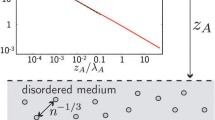Abstract
We study the electric potential and field produced by disordered distributions of charge to see why clumps of charge do not produce large potentials or fields. The question is answered by evaluating the probability distribution of the electric potential and field in a totally disordered system that is overall electroneutral. An infinite system of point charges is called totally disordered if the locations of the points and the values of the charges are random. It is called electroneutral if the mean charge is zero. In one dimension, we show that the electric field is always small, of the order of the field of a single charge, and the spatial variations in potential are what can be produced by a single charge. In two and three dimensions, the electric field in similarly disordered electroneutral systems is usually small, with small variations. Interestingly, in two and three dimensional systems, the electric potential is usually very large, even though the electric field is not: large amounts of energy are needed to put together a typical disordered configuration of charges in two and three dimensions, but not in one dimension. If the system is locally electroneutral—as well as globally electroneutral—the potential is usually small in all dimensions. The properties considered here arise from the superposition of electric fields of quasi-static distributions of charge, as in non-metallic solids or ionic solutions. These properties are found in distributions of charge far from equilibrium.
Similar content being viewed by others
References
D.C. Brydges A. Martin Ph. (1999) ArticleTitleCoulomb systems at low density: a review J. Stat. Phys. 96 IssueID5/6 1163–1330 Occurrence Handle10.1023/A:1004600603161
S. Karlin H.M. Taylor (1981) A Second Course in Stochastic Processes Academic Press New York
C.M. Bender S.A. Orszag (1999) Advanced Mathematical Methods for Scientists and Engineers Springer New York
J. L. Jensen, Saddlepoint Approximations (Oxford Statistical Science Series, 16) (Oxford University Press, 1995).
V. Rothschild N. Logothetis (1985) Probability Distributions John Wiley New York
J. M. G. Barthel and H. Baumgartel (ed), H. Krienke, Physical Chemistry of Electrolyte Solutions: Modern Aspects Steinkopf, Dietrich Pub. 1998).
D. A. McQuarrie (1976) Statistical Mechanics Harper and Row NY
D. Henderson (Eds) (1992) Fundamentals of Inhomogeneous Fluids Marcel Dekker New York
P.A. Martin (1988) ArticleTitleSum Rules in Charged Fluids Rev. Mod. Phys. 60 1076–1127 Occurrence Handle10.1103/RevModPhys.60.1075
J. Barthel, R. Buchner, and M. Münsterer, Electrolyte Data Collection Vol. 12, Part 2: Dielectric Properties of Water and Aqueous Electrolyte Solutions. Frankfurt am Main, DECHEMA, 1995.
J.N. Chazalviel (1999) Coulomb Screening by Mobile Charges Birkhäuser Boston
C. Kittel (1996) Introducation to Solid State Physics, 7th Ed John Wiley and Sons New York
K. Knopp (1990) Theory and Application of Infinite Series Dover NY
P. Mohazzabi T.A. Fournelle (April 2004) ArticleTitleEvaluation of Ill-Behaved Power Series Am. Math. Monthly. 111 IssueID4 308–321 Occurrence HandleMR2057185
L. Breiman, Probability (Classics in Applied Mathematics, No.7) (SIAM Publications (Reprint edition) 1992).
E. W. Weisstein et al. “Cantor Set.” From MathWorld–A Wolfram Web Resource. http://mathworld.wolfram.com/CantorSet.html
G.F. Carrier M. Krook C.E. Pearson (1966) Functions of a Complex Variable McGraw-Hill NY
J.D. Jackson (1975) Classical Electrodymnics 2nd Ed Wiley NY
D. Knödler W. Dieterich C. Lonsky A. Nitzan (1995) ArticleTitleNonlinear relaxation and solvation dynamics in a Coulomb lattice gas, J Chem. Phys. 102 IssueID1 465–470 Occurrence Handle10.1063/1.469424
M. S. Ghausi and J. J. Kelly Introduction to Distributed-Parameter Networks (New York, Holt Rinehart & Winston, 331, 1968).
J.J.B. Jack D. Noble R.W. Tsien (1975) Electric Current Flow in Excitable Cells Clarendon Press New York, Oxford
Author information
Authors and Affiliations
Corresponding author
Rights and permissions
About this article
Cite this article
Singer, A., Schuss, Z. & Eisenberg, R.S. Attenuation of the Electric Potential and Field in Disordered Systems. J Stat Phys 119, 1397–1418 (2005). https://doi.org/10.1007/s10955-005-3025-1
Received:
Accepted:
Published:
Issue Date:
DOI: https://doi.org/10.1007/s10955-005-3025-1




